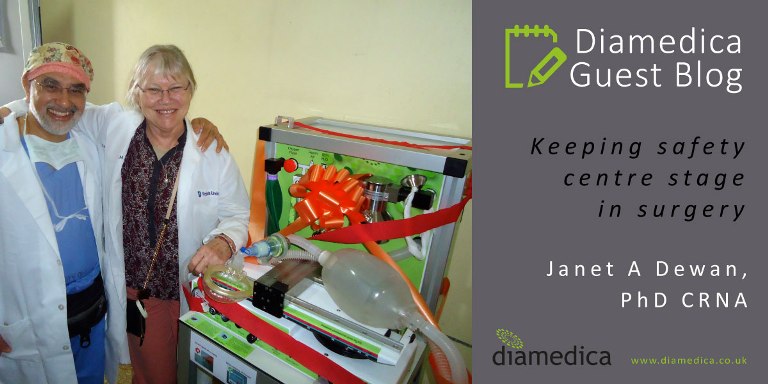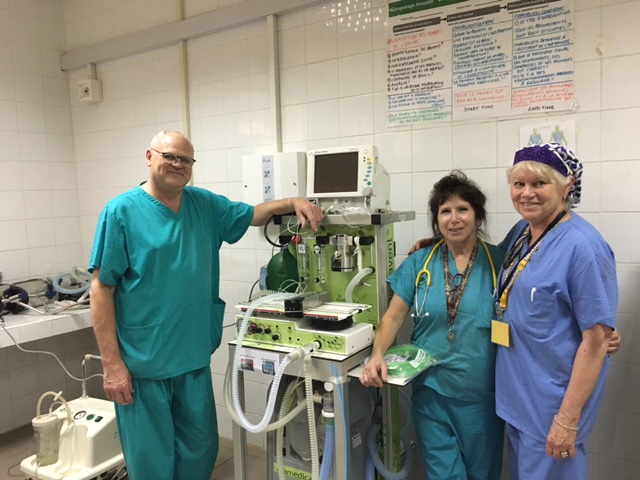News
Blog
November 8th, 2017
We are delighted to introduce Janet A Dewan, PhD CRNA, of Northeastern University, Boston, MA. Janet is our guest blogger this month and gives a frank account of the challenges faced by medical professionals working in low resource settings.

Dr Saifuddin Mama, sugeon, and Janet Dewan, anesthetist, happily patricipate as IOWD donates Glostavent anesthesia machine to Kibagabaga Hospital, Kigali, Rwanda
With estimates that as many as 5 billion people do not have access to safe, essential surgery we may assume that training more specialty surgeons and anesthesia providers will correct the deficiency.
Additional skilled health professionals are surely needed, but without sustainably functioning equipment, trained professionals cannot deliver even basic safe clinical care, resulting in professional dissatisfaction, impeded access and preventable complications.
Background
I teach and practice anesthesia in the US and Africa. My first global health experiences were at L'hopital d'Agadez, Niger, in 1974.
My current projects focus on working with anesthetists in Liberia and Rwanda. Multiple factors contribute to the unevenly distributed progress and disparity in access to surgical care delivery I have seen during my career.
I have been both frightened and frustrated when resource constraints hamper our ability to make even basic surgical care successful and safe, forcing us to decide if delivering or refusing care is the ethical decision.
Developing health system operating theatres often resemble a dumping ground for discarded then donated, fragile and complex devices. Charity gifted anesthesia machines, which cannot function without high-pressure oxygen source and electricity, function as writing tables and door-stops, in systems with limited or unreliable resources.

Sheila Murphy CRNA, Janet and Robert with the Glostavent set up in the theatre at Kibagabaga Hospital
Making a Diamedica connection
Meeting Robert Neighbour, Diamedica’s director on line empowered me. Around 2011, I had posted a photo of a complex, barely functional anesthesia machine I had come across in an African OR, hoping for advice that might make it function.
I asked on the global health blog page if it was a Glostavent, because I had heard they were being used in Africa. That very day Robert responded that the photo was definitely NOT a Glostavent, but he did not stop there.
He sent me photos, and described how a Glostavent functions in low resource environments. I had lots of questions and he answered every one with a developer's knowledge, but in language applicably relevant to a clinician's issues.
Previous surgical constraints and frustrations
The NGO with which I am involved performs obstetric fistula repair and other surgeries in Rwanda. We have worked at the same district hospital three times a year since 2010, so feel a long-term mutual commitment.
The hospital administration allows our NGO to use two operating rooms for our two-week missions, but because of the lack of safe anesthesia machines and monitors, the anesthesia team initially refused to perform more than one general anesthetic at a time, limiting the surgical capacity for complex cases.
The demand for uro-gynecologic surgical service is enormous, with many patients seeking care. Having the contributions of skilled volunteer surgeons limited by inadequacy of apparatus frustrated us all.
Lack of safe, functional equipment became our rate-limiting step. Our NGO directors asked me how we could safely perform more surgeries, running two simultaneous general anesthetics. I told them I was communicating with someone in Britain who manufactured a machine specifically designed for use in low resource settings.

Robert Neighbour and Mary O'Sullivan, DNP CRNA and SEED Global Health Partnership volunteer, at Phebe Hospital, Liberia
A turning point
At that point I had never seen a Glostavent, but Robert's description, assurance of on-site support and review of literature made me confident this was a machine we should provide for the hospital.
With the support of the International Organization for Women and Development (IOWD) and generous donors we were able to purchase a Glostavent for our district hospital.
Often international business dealings can hit procedural road blocks, but working in partnership with the Diamedica staff, most notably Rachel Currie-Cathey, was seamless in every way.
Our machine was delivered in Africa a few weeks before our next scheduled arrival, but not just dropped off – Robert Neighbour himself went to Kigali and conducted a workshop to instruct local anesthetists and others in its function and care.
That Glostavent has been in continuous service at the hospital for several years now, improving capacity and safety whether we are there or not.
Ongoing support
Bringing equipment is easier than keeping it operational. Of most significant importance is the support service that Diamedica provides to keep these simply designed machines functioning. I have called their offices several times from Africa for minor function questions or repairs and I have always gotten a response within an hour that solves, and explains, the issue.
Thanks to other generous donors, our neonatal unit has also benefited from installation of the extraordinary Diamedica Baby CPAP machines, personally set up with teaching by Robert Neighbour and the Diamedica team. You can watch a film about the Baby CPAP success in Rwanda here.

Robert carrying out routine maintenance at Kibagabaga hospital
Going the extra mile
Buying and installing one Glostavent anesthesia machine was not the end of my association with Diamedica. In 2016, I was at the International Federation of Nurse Anesthetists Congress in Glasgow, Scotland. Diamedica was present exhibiting.
I mentioned that I was going to Liberia to help with curriculum redesign for nurse anesthesia training. Years earlier, Robert had installed two Glostavents at the very hospital I would be visiting, and he wondered if, after the Ebola epidemic, they were still functioning.
Without hesitation, right there on the exhibit floor in Glasgow, he said: "I can go with you for a few days."
Robert's presence, two months later in Liberia, was indispensable, not only because he performed the relatively minor maintenance needed to return the Glostavents that had been doused in bleach, to safe function, but because of the lessons he gave to the anesthetists and hospital staff on protecting equipment exposed to the vagaries of power supply in developing systems.
Additionally, we were able to procure sturdy, battery backup powered, portable, low resource monitors from Diamedica that include capnography. This is a standard of care monitoring modality that the nurse anesthesia students learned about in the classroom, but had not had the opportunity to use in practice.
Partnerships to prioritise safety
Association with Diamedica along with adherence to the Safe Surgery Saves Lives and Lifebox Foundation Protocols, have empowered me to see that we can deliver care in underserved areas without jeopardizing basic safety standards.
Closing the chasm to assure access to essential and emergency surgery requires that various disciplines form alliances to reach benchmarks. Policy makers, health system administrators, clinicians, political leaders, scientists and those in the private business sector working together can support and enhance each other's impact.
Robert Neighbour translates the inspired Diamedica business office and medical engineering laboratory mission to clinical practice by coupling perseverance toward sustainable long-term goals with generous, on the ground, face-to-face encounters.
This way, proper equipment becomes a facilitator of safe care rather than the rate-limiting ingredient.